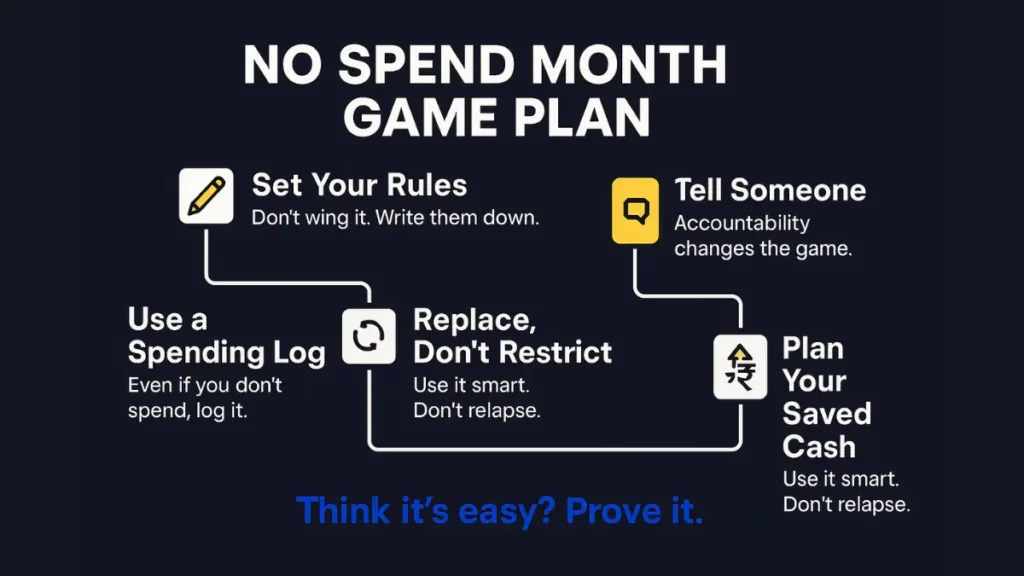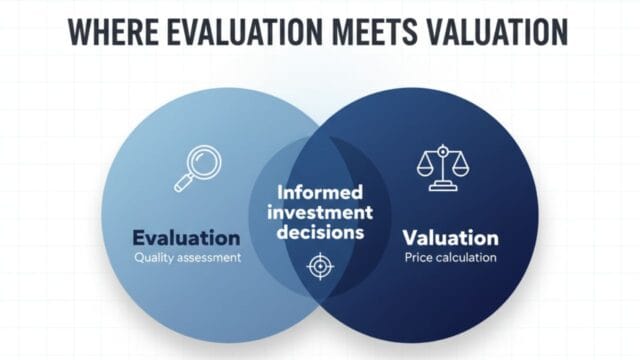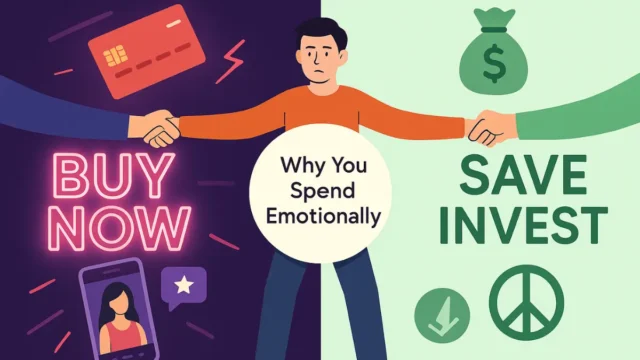Follow Us
No Spend Month Challenge with Free Printable Template PDF

Table of Contents
What Is a No Spend Month Challenge?
A No Spend Month is a 30-day challenge where you intentionally stop all non-essential spending. That means no impulse buys, no dining out, no new clothes, just the essentials like rent, groceries & bills.
The goal isn’t to punish yourself or live like a monk. It’s to press pause on mindless spending, identify financial leaks, and reset your relationship with money.
Think of it like a money detox: you’re cutting the noise, spotting patterns, and finally seeing where your cash actually goes. And yes, it works.
Scroll to bottom or click here to get your free No Spend Challenge Template.
First off – What is a “No Spend Month” really?
It’s exactly what it sounds like.
For 30 days, you don’t spend money on anything non-essential. That means no eating out, no online shopping, no random midnight food orders, no new gym leggings “for motivation.”
You stick to the basics:
- Rent
- Groceries (actual groceries – not Oreos & impulse chocolate)
- Utilities
- Medical stuff
- Gas or public transport
Everything else? Off limits.
And no, you don’t get to “reward yourself” with a treat or shopping spree haul when it’s over. This is not a damn crash diet. It’s a mindset reset.
Why this works (even if you think you are already “pretty good” with money)
Most people have no clue how much they’re bleeding through tiny, daily habits. I’m talking ₹300 here, ₹500 there, death by a thousand transactions.
Here’s a quick experiment: Go check your last month’s bank statement or order history on platforms. Seriously, do it.
Now highlight everything that wasn’t essential. Food delivery, random subscriptions, quick Amazon buys, online courses you never opened, dumb weekend plans, you name it.
Add it all up.
Shocked? Thought so.
That’s the magic of a No Spend Month. It forces awareness. You start noticing every little swipe, every “just this once,” every scroll-induced impulse buy.
And once you see it, you can’t unsee it.
But here’s where people screw it up…
They think the goal is just to stop spending.
Nah. That’s step one.
The real power comes from what happens in that space between “I want to buy something” and “Wait… why?”
That pause? That discomfort? That’s gold. That’s where the habit change begins.
Because here’s the ugly truth most finance influencers won’t tell you:
You don’t have a money problem. You have a decision-making problem.
You are not broke because coffee is expensive. You are broke because you are chasing dopamine hits with your debit card. And this challenge is about breaking that cycle.
So how do you actually win at a No Spend Month?
It’s not about being perfect. You will slip up. You’ll get tempted. You’ll open Zomato “just to browse.”
The goal isn’t to shame yourself. The goal is to build conscious friction.
Every time you want to spend… pause. Ask yourself:
- “Do I need this?”
- “Will I remember this purchase in a month?”
- “Is this solving a real problem or killing boredom?”
Seven times out of ten, you’re just distracting yourself. Spend with intention or don’t spend at all.
No Spend Month: How to Reset Your Money Habits for Good
So you get it now, this challenge isn’t just about “not spending.”
It’s about interrupting autopilot. It’s about breaking the cycle of blind consumerism & finally calling yourself out.
But let’s be real: It’s easy to feel hyped up at the start.
Week one, you are motivated. You are meal prepping like a fitness influencer. You are deleting shopping apps. You’re feeling unstoppable.
Then week two hits.
Suddenly your mood’s off, your brain starts whispering, “You’ve been good… maybe just one delivery?” And boom — you are back to square one with a guilt sandwich & a side of regret.
So how do you actually stick with it when things get uncomfortable?
1. Set Your Rules Before You Start (And Write. Them. Down.)
Don’t go into this winging it. That’s a trap.
You need a clear-as-day list of:
- What counts as “essential” for you
- What’s strictly off-limits
- Any exceptions (be honest, not soft)
For example:
✅ Groceries, rent, medical stuff, petrol
❌ Eating out, Swiggy/Zomato, clothes, gadgets, paid entertainment
⚠️ 1 social event allowed if it’s under ₹500 and pre-approved
2. Tell Someone: Accountability Changes the Game
You don’t have to tweet it to the world, but loop in one person you trust, probably your mother, as they are best at it.
Tell them:
“Hey, I’m doing a No Spend Month. I’ll update you weekly; make fun of me if I cave.”
That one sentence will keep you more honest than any budgeting app ever could.
Even better? Do it with a friend. Turn it into a low-key challenge. Loser buys coffee in April (after the challenge, obviously).
3. Use a “Spending Log” – Yes, Even if You Don’t Spend
This sounds dumb until you try it.
Every day, write down:
- What you wanted to buy
- Why you wanted it
- What you did instead
Sounds simple, right? But holy hell, this is where the pattern-breaking happens.
You will start seeing the emotional triggers. Stress, boredom, FOMO, low energy… and how often your default response is “Buy something.”
Once you see the pattern, you can change it.
4. Replace, Don’t Just Restrict
Here’s the biggest rookie mistake: people cut spending without replacing the underlying behavior.
You stop shopping, but don’t replace it with anything meaningful. Now you are bored, annoyed, and scrolling Amazon again by Day 12.
The trick is redirecting that energy.
- Missing food delivery? Try new recipes or challenge yourself to cook something under a budget.
- Feeling like you “need” a retail therapy hit? Go clean out your closet instead.
- Craving entertainment? Rediscover YouTube, podcasts, books or just be okay with being bored sometimes. It won’t kill you.
This isn’t punishment. It’s reprogramming.
5. Have a Plan For The Money You Save
Here’s where most people screw up after 30 days.
They finish the challenge… and then go right back to old habits.
Don’t just sit on that saved cash. Assign it. Immediately.
Ask yourself:
- Can I finally clear a credit card?
- Can I boost my emergency fund?
- Can I invest this into something that actually grows?
Real Talk: What You’ll Feel (And Why That’s the Point)
You’re going to feel uncomfortable.
You’re going to get irritated. You’ll have FOMO. You’ll feel “behind” when everyone else is spending like it’s a sport.
Good.
That discomfort? That’s the exact sign you’re on the right track.
You are peeling off the layers of numbing we all do with spending. You are learning how to sit with urges without acting on them. You are finally seeing your money for what it is: a tool, not a pacifier.
Download the No Spend Month Challenge Printable Template PDF.
Download the BBM No Spend Month Starter Kit (free 4-page printable).
Final Thoughts
A No Spend Month won’t make you rich. But it’ll wake you up.
You’ll see how money leaks from your life in ways you never noticed. You’ll understand your triggers. You’ll rebuild trust with yourself.
And once you’ve done it once?
You’ll never be the same kind of spender again.
You’ll start asking better questions. You’ll stop feeling guilty every time you check your bank balance. You’ll stop being a slave to your next payday.
That’s the real win.
And you don’t need a finance degree to get there. Just 30 days of being intentional.
So if you’re reading this and thinking, “I should probably try this…” — don’t overthink it.
Pick a start date.
Write your rules.
Commit.
Then come back in 30 days & tell us what changed.
Trust me, something will or else you will learn how to live if you are low on money!
Disclaimer:
This content is for informational purposes only and should not be considered financial advice.
Read full Disclaimer.




